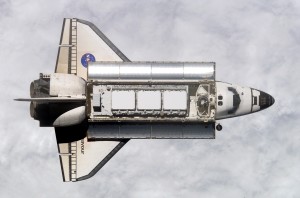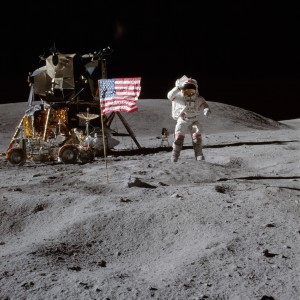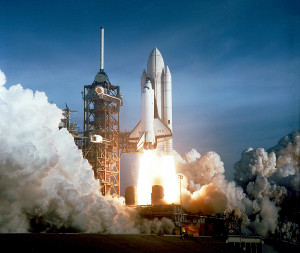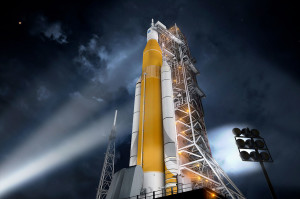I pay pretty close attention to NASA and current space related activities on a whole; I like to stay current on a subject that, I feel, is the single most important subject to the longevity of the human race. Of course, being an American, I am paying closest attention to our own manned space efforts, most importantly the development of the SLS launch vehicle, and the Orion crew vehicle, which will, sometime in the next decade, send a crew back to the Moon, and hopefully another crew to Mars. At least, that’s the plan.
Today just happens to be the 1 year anniversary of the first flight of Orion, EFT-1, a completely successful stress test of the vehicle in an actual space flight. Orion, the vehicle that will take us back to the Moon, and beyond, has already had one flight, with more coming as the NASA budget allows… but this isn’t good enough for some people.
Now, I’m not going to go into all the nitty-gritty of politics, funding, etc, but inevitably politics plays a key factor in why the United States is in the situation it is. The situation is multi faceted, and comments are across the board, but I’m going to focus here on what I find to be the most, for lack of a better term, idiotic attitudes to the current US space situation.
Also keep in mind, I have tried to keep this list somewhat short… seriously, I could go on and on about people complaining about space travel, and this article was already a chore to write.

Didn’t they close NASA in 2011?
I hear this one far more often than you think I would. No, NASA in no capacity was “closed” or “shut down” in 2011. What was ended was the Space Shuttle Program. By the end of it’s 30 year history, the Shuttle had proven to be less cost effective than envisioned in the 70’s, and due to several (in hindsight) poor design choices, failures in the vehicle cost the lives of 14 astronauts in the Challenger and Columbia disasters of 1986 and 2003. After completing assembly of the US segment of the International Space Station, the Shuttle Program was ended so that those resources could be moved towards future projects, originally the Constellation program which was quickly evolved into the more targeted and more cost-efficient (in design) SLS and Orion program being developed today.
This comment also totally ignored the multitude of ongoing unmanned missions, from New Horizons and it’s historic Pluto flyby in July of 2014, to the still-functioning Voyager probes, launched in 1977, which are still sending back information about the absolute edges of our solar system and the beginnings of interstellar space. Those are as much NASA projects as the Shuttle was, and as Apollo was, but no, no one ever thinks about those.
We shouldn’t have wasted time with the Shuttle, we should have went to Mars!
Plans from even the very earliest days of NASA envisioned a multi-purpose, reusable space truck to help build space stations, repair satellites, and conduct research in Earth orbit in conjunction with the planned Moon and logical future Mars missions. However, by the time of the launch of Apollo 11, in 1969, the NASA budget had already started to be slashed. Nixon deviated funding to the ever-growing war in Vietnam, and by the time of Apollo 17 in December 1972, 3 Apollo lunar missions had been canceled. Surplus hardware was now relegated to a scaled back Apollo Applications Program that only included Skylab, and the Apollo-Soyuz Test Project – after 1975, there would be no more Apollo.
The one good news was that, while Apollo 16 was on the Moon, Congress approved the Space Shuttle, which was at the time the most important, and then considered most cost effective way to continue space research. The United States would go 6 years between ASTP and STS-1, the first flight of the Shuttle, with no manned flights.

During that time, the Soviets would continue their rather successful Salyut space station program, having years earlier given up on flights to the Moon. Perhaps they were on to something. Whatever case, the Shuttle was what we had, and ya know what? It worked wonderfully for what we needed it to do… however, failures, as mentioned before, taught us some harsh lessons in what you should and shouldn’t do when it comes to space flight.
We shouldn’t have canceled the Shuttle.
Look, I love the Shuttle Program for both what it was to be, and what it really became. Arguably the most complex machine ever built, the Shuttle vehicle stack was a beautiful vehicle, and a true space truck, as envisioned in the original design ideas.
The problems came in elements of the design and the original intentions for the Shuttle.
See, the Shuttle was originally intended to be launched using old Saturn hardware. Of course, with the construction of Saturn boosters ended after the initial run, the Shuttle was re-designed to launch using the configuration it eventually flew with – 2 Solid Rocket boosters on opposite sides of a main fuel tank, with the actual orbiter strapped to the side of this fuel tank.
The size of the Shuttle was originally going to be much smaller, too – it was expanded via United States Department of Defense requests to be able to carry their largest payloads. Why though? Why not just use any old rocket, like Titan, that already launched these payloads?
Costs. The Government wanted the Shuttle to take over all United States launches, and phase out all of the expensive, one-time-use rockets that had carried all other payloads into orbit.

This never happened, though, as on the 25th mission of the program, the Shuttle Challenger disintegrated 73 seconds into it’s 10th flight, killing the crew. This was due to flaws in the inherent design of the Shuttle system, in conjunction with an ever-increasing pace of launches, and “creeping normalcy” where common oddities that should be addressed eventually become so normal no one questions them.
After this disaster, the shuttle was relegated to research missions, later dockings with Mir, and helping construct the International Space Station. Satellite launches from the shuttle were only those which absolutely required humans to assist directly, such as in the launching of Hubble, or other special NASA missions where such was deemed safe. No other commercial payloads would fly on the Shuttle, instead being relegated to Atlas, Titan, and Delta boosters.
This would happen again in 2003 with Columbia, which was destroyed on re-entry due to damage caused by foam strike onto the heat shield – something that happened on virtually every launch, but in this case, the strike damaged a critical part of the left wing of the orbiter, dooming it and it’s crew. Once again, the flaws in the shuttle let us see that this vehicle, as capable as it was, was incredibly dangerous, and the decision was made to end the program after the completion of the ISS. Indeed, excluding the final Hubble Space Telescope servicing mission, all after the Columbia disaster were ISS support flights.
The cost of supporting the Shuttle AND a new project would have been prohibitive.
Indeed, that’s really what the point here is, isn’t it?
That annoying little thing called money…
Really, if you aren’t noticing, I’m surprised. Everything I have mentioned here boils down to one key factor – costs. NASA doesn’t get near as much money as everyone thinks it does. Somewhere around half a cent of every dollar in tax money taken from the population actually goes to NASA. This is a fraction of what other government agencies receive, and yet some people actually say it is funded too much, or adequately.
People groan that there is 1 planned SLS launch a year, vs how we had 4 Apollo launches in 1969, and yeah, I hate that too, but it’s the best NASA thinks they can do with the money they receive. The 1969 Budget, while being cut from 1968 and 1967 values, was still a large portion of the federal budget, far from the %0.5 NASA gets today.
No, I’m not trying to turn this into something political, but these particular 3 criticisms, or common comments to be more accurate, really do irk me because these are often the same people who would say they don’t need to be funded, or we should focus our money on the Military (yeah, on aircraft we will never use. Wonderful)
In fact, that brings up a funny thought that I will end with: Space flight of any kind started as a side effect of missile technology, namely the ICBM. Thankfully, no ICBM was ever used to deliver a nuclear warhead, but what to do with all those unused missiles? One would call them as much a waste as any modern strike aircraft that never sees action, right?
Well, both the United States and the Soviet Union did something clever – Many unused ICBM’s over the past 50 years have been converted into satellite launchers directly. Yes, variants of missiles like the R-7, the Atlas, the Thor, and even the Titan, were made as dedicated launch vehicles, but what I am speaking of are what were once nuclear missiles, converted to send a peaceful payload into orbit.
Just let that sink in, how a machine designed for war can just as easily send up a machine to help keep peace across the world.

